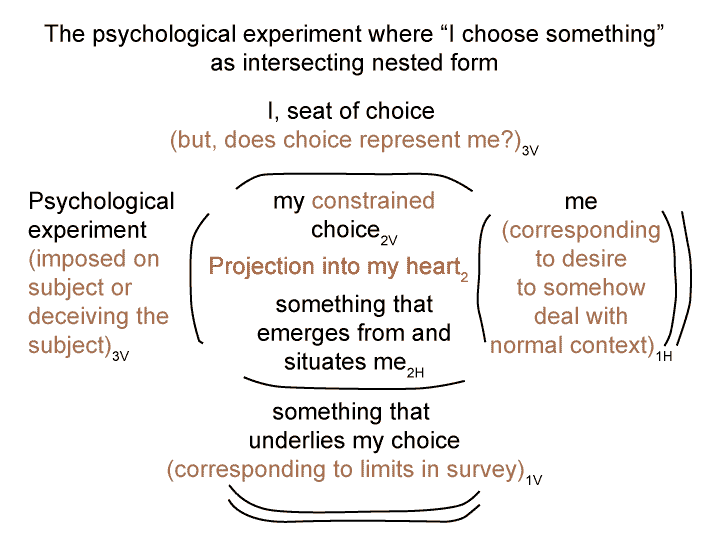Monthly Archives: August 2019
Man and Sin by Piet Schoonenberg (1964) 2.3 YJ
Summary of text [comment] pages 87 and 88
[For the thought experiment where ‘I choose something’, the interscope does not have a heart.
The intersection has a heart and that heart is broken. My heart2 is the single actuality containing my choice2V and something that situates my potential2H.
The imposition of a psychological experiment generates contradictions within these two actualities.]
Man and Sin by Piet Schoonenberg (1964) 2.3 YI
[Obviously, the interscope and intersection are exclusive.
The nested forms go either one way or the other.]
Man and Sin by Piet Schoonenberg (1964) 2.3 YH
[When can a researcher know whether the interscope or intersection applies to the conditions of the survey?]
Man and Sin by Piet Schoonenberg (1964) 2.3 YG
Summary of text [comment] pages 87 and 88
[What about surveys where the intersection applies?
What about surveys where ‘the something that I may choose1V’ does not correspond to ‘the something that emerges from and situates me2H’?]
Man and Sin by Piet Schoonenberg (1964) 2.3 YF
[Psychologists only can claim that survey measurements represent ‘the potentials inherent in the subject under investigation1a’ under the conditions where the interscope applies. Surveys only apply to sensible construction.]
Man and Sin by Piet Schoonenberg (1964) 2.3 YE
[Base-level bias must exist in social science experiments because the researcher defines the thought experiment3a that stimulates a response in the subject1a.
The response (the upwelling of potential in the subject1a plus the potential of the survey to impose constraints1b) always conforms to the stimulus (the normal contexts3a&3b that the event occurs in).
This also explains why many social scientists rely on deception. Deception has the same character as bias. All experiments exhibit ‘base-level deception.]
Man and Sin by Piet Schoonenberg (1964) 2.3 YD
Summary of text [comment] pages 87 and 88
[The psychologist may think that “he” is measuring my mental potential1a as if it were an actuality. After all, on the situation level, the content level nested form is packaged as the possibility of something that the subject might choose1b.
The psychologist may not imagine that “he” is measuring the hidden features in the actuality in the thought experiment where ‘I choose something’.]
Man and Sin by Piet Schoonenberg (1964) 2.3 YC
[The only other actuality is ‘my choice2b’.
This item can legitimately be observed and measured because it belongs to the realm of actuality twice, as situation and as element in a nested form.
Again, the researcher is concealed in the way that the survey can be marked.
For example, the researcher may have already limited possibility1b to a choice from 1 to 5.]
Man and Sin by Piet Schoonenberg (1964) 2.3 YB
Summary of text [comment] pages 87 and 88
[So what are survey questions actually measuring?
Something2a is the actuality that gains the subject’s attention. Yet, even this actuality is one element in a dyad.
The other element is the researcher and the conditions.
These are very difficult to assess. Consequently, the thought experiment3a treats these as constants.]

